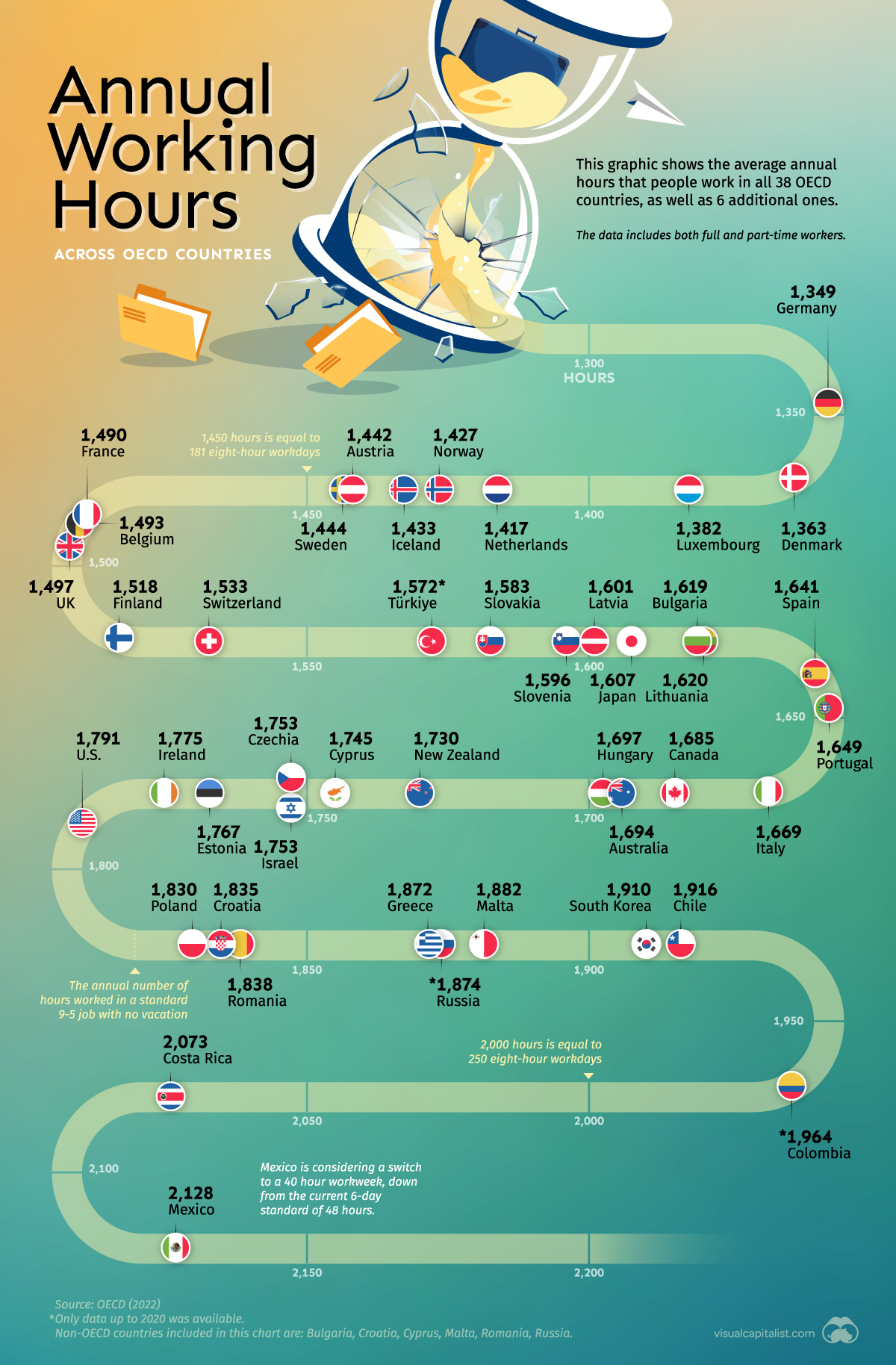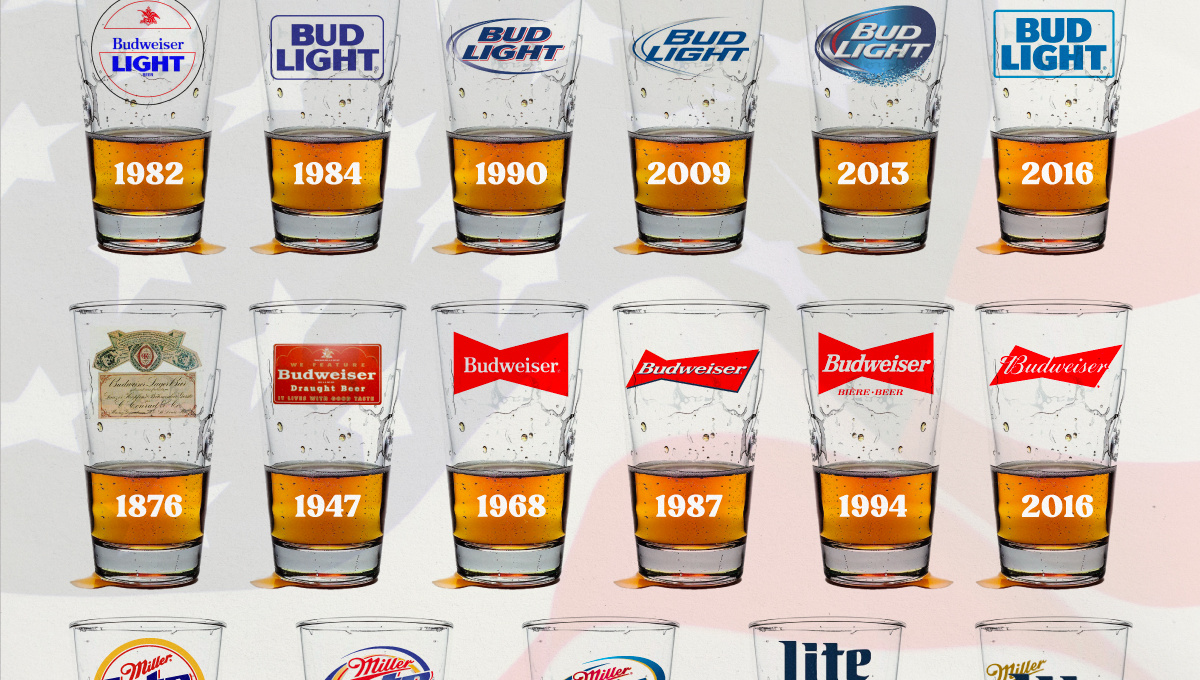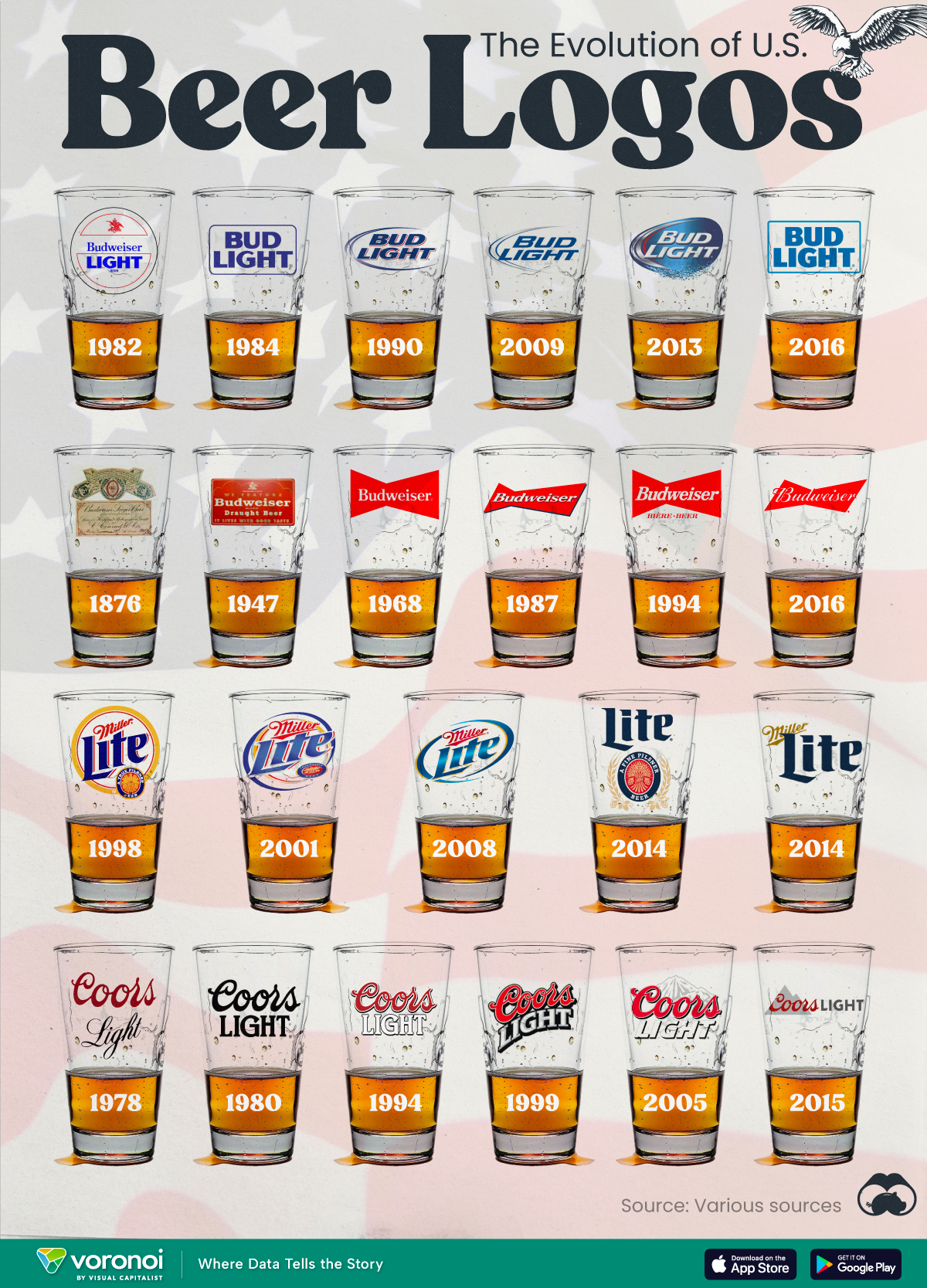Business
Visualizing Annual Working Hours in OECD Countries

Visualizing Annual Working Hours in OECD Countries
Comparing the number of hours people work in different countries can provide insight into cultural work norms, economic productivity, and even labor laws.
With this in mind, we’ve ranked OECD countries (plus a few others) based on their average annual hours worked. Note that this data includes both full-time and part-time workers.
Data and Highlights
The data we sourced from OECD is listed in the table below. All figures are as of 2021 (latest available), with the exception of Colombia, Russia, and Türkiye which are as of 2020.
| Country | Average annual hours worked |
|---|---|
| 🇲🇽 Mexico | 2,128 |
| 🇨🇷 Costa Rica | 2,073 |
| 🇨🇴 Colombia | 1,964 |
| 🇨🇱 Chile | 1,916 |
| 🇰🇷 South Korea | 1,910 |
| 🇲🇹 Malta* | 1,882 |
| 🇷🇺 Russia* | 1,874 |
| 🇬🇷 Greece | 1,872 |
| 🇷🇴 Romania* | 1,838 |
| 🇭🇷 Croatia* | 1,835 |
| 🇵🇱 Poland | 1,830 |
| 🇺🇸 United States | 1,791 |
| 🇮🇪 Ireland | 1,775 |
| 🇪🇪 Estonia | 1,767 |
| 🇨🇿 Czech Republic | 1,753 |
| 🇮🇱 Israel | 1,753 |
| 🇨🇾 Cyprus* | 1,745 |
| 🇳🇿 New Zealand | 1,730 |
| 🌐 OECD average | 1,716 |
| 🇭🇺 Hungary | 1,697 |
| 🇦🇺 Australia | 1,694 |
| 🇨🇦 Canada | 1,685 |
| 🇮🇹 Italy | 1,669 |
| 🇵🇹 Portugal | 1,649 |
| 🇪🇸 Spain | 1,641 |
| 🇱🇹 Lithuania | 1,620 |
| 🇧🇬 Bulgaria* | 1,619 |
| 🇯🇵 Japan | 1,607 |
| 🇱🇻 Latvia | 1,601 |
| 🇸🇮 Slovenia | 1,596 |
| 🇸🇰 Slovakia | 1,583 |
| 🇹🇷 Türkiye | 1,572 |
| 🇨🇭 Switzerland | 1,533 |
| 🇫🇮 Finland | 1,518 |
| 🇬🇧 United Kingdom | 1,497 |
| 🇧🇪 Belgium | 1,493 |
| 🇫🇷 France | 1,490 |
| 🇸🇪 Sweden | 1,444 |
| 🇦🇹 Austria | 1,442 |
| 🇮🇸 Iceland | 1,433 |
| 🇳🇴 Norway | 1,427 |
| 🇳🇱 Netherlands | 1,417 |
| 🇱🇺 Luxembourg | 1,382 |
| 🇩🇰 Denmark | 1,363 |
| 🇩🇪 Germany | 1,349 |
*Non-OECD country
At the top is Mexico, where the average worker clocks over 2,000 hours per year. This reflects the country’s labor dynamics, which typically involves a six-day workweek. For context, 2,128 hours is equal to 266 eight-hour workdays.
The only other country to surpass 2,000 annual hours worked per worker is Costa Rica, which frequently tops the World Economic Forum’s Happy Planet Index (HPI). The HPI is a measure of wellbeing, life expectancy, and ecological footprint.
Looking at the other end of the list, the two countries that work the fewest hours are Germany and Denmark. This is reflective of the strong labor laws in these countries as well as their emphasis on work-life balance.
For example, the German Working Hours Act (Arbeitszeitgesetz) states that daily hours of work may not exceed eight hours. Days can be extended to 10 hours, but only if it averages out to eight hours per working day over a six-month period.
Working fewer hours doesn’t mean that a country is becoming less productive, though. Germany is known for its high value industries like automotive and pharmaceuticals, where robotics and other technologies can greatly enhance productivity.
This is supported by GDP per capita, in which Germany has grown substantially since 2000.
Limitations of this Data
A limitation of this dataset is that it aggregates both full-time and part-time workers. This means that in a country like Japan, where almost 40% of the workforce is non-regular (part-time, contract, etc.), the average figure could be skewed downwards.
Japan is known for its grueling office culture, and it’s likely that many workers are logging significantly more hours than the 1,607 figure reported.
If you enjoy comparisons like these, consider taking a look at our ranking of cities with the best work-life balance.
Misc
The Evolution of U.S. Beer Logos
In this graphic, we analyze the evolution of popular U.S. beer logos like Budweiser, Coors Light, Bud Light, and more.

The Evolution of U.S. Beer Logos
This was originally posted on our Voronoi app. Download the app for free on iOS or Android and discover incredible data-driven charts from a variety of trusted sources.
Despite selling a popular product, beer companies have to be creative to stand out in a competitive market.
In this graphic, we analyze the evolution of some U.S. beer logos based on various sources. We chose brands based on a mixture of criteria, including popularity (based on YouGov surveys), availability of logo assets, and those with interesting developments.
Bud Light Back to the ’80s
Despite recent backlash and calls for a boycott after sending a commemorative can to transgender influencer Dylan Mulvaney, Bud Light remains one of America’s best-selling beers.
The brand of light beer, owned by the Anheuser-Busch company, has switched from its more circular logo with italic letters adopted in the 1990s back to the Bud Light badge of the 1980s. It is composed of heavy uppercase lettering, written in two levels in a shade of blue with the inscription placed on a solid white background and enclosed in a thin rectangular frame.
Miller Lite Goes Old School
After following a similar approach to Bud Light’s branding throughout the 2000s, Miller Lite decided to undergo a major rebranding in 2014.
The company returned to its 1970s roots, once again combining a white can with its original blue, gold, and red logo. The redesign was largely considered a success, given that Miller Lite sales immediately increased following the change.
A Symbol of American Brewing
The oldest brand on our U.S. beer list, the Budweiser logo, has undergone more than 15 changes over the years.
The design of two connected triangles represents a red bow tie, as a symbol of American brewing.
The colors of the Budweiser logo include a vibrant red, which helps the logo stand out and be easily recognizable from a distance. Studies also suggest that the color red stimulates appetite. Meanwhile, the white inscription symbolizes purity and cleanliness.
Curious to learn more about the beer market? Check out this graphic about global beer consumption.
-

 Markets5 days ago
Markets5 days agoVisualizing Global Inflation Forecasts (2024-2026)
-

 Green2 weeks ago
Green2 weeks agoThe Carbon Footprint of Major Travel Methods
-

 United States2 weeks ago
United States2 weeks agoVisualizing the Most Common Pets in the U.S.
-

 Culture2 weeks ago
Culture2 weeks agoThe World’s Top Media Franchises by All-Time Revenue
-

 Visual Capitalist1 week ago
Visual Capitalist1 week agoBest Visualizations of April on the Voronoi App
-

 Wealth1 week ago
Wealth1 week agoCharted: Which Country Has the Most Billionaires in 2024?
-

 Markets1 week ago
Markets1 week agoThe Top Private Equity Firms by Country
-

 Markets1 week ago
Markets1 week agoThe Best U.S. Companies to Work for According to LinkedIn















